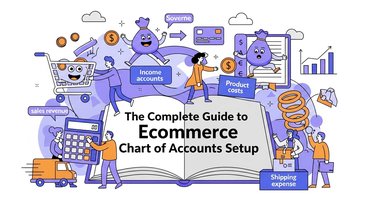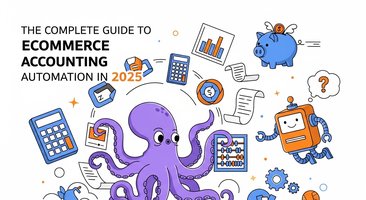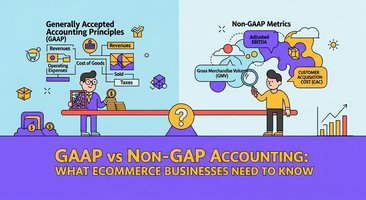Cash flow forecasting isn't just about knowing how much money you'll have next month—it's about building a predictable, scalable ecommerce business that can weather seasonal fluctuations, capitalize on growth opportunities, and avoid the cash crunches that kill promising companies. In today's competitive landscape, accurate cash flow forecasting has become the difference between businesses that scale sustainably and those that struggle to survive their own success.
For ecommerce businesses, cash flow forecasting presents unique challenges and opportunities. Unlike traditional retail, online businesses face complex payment timing, seasonal demand swings, inventory investment cycles, and multi-channel revenue streams that make prediction both more difficult and more crucial.
This comprehensive guide will teach you how to master ecommerce cash flow forecasting, leverage predictive analytics, and use tools like Klavena to transform your financial planning from reactive to proactive.
Understanding Cash Flow Forecasting for Ecommerce
Cash flow forecasting is the process of predicting the inflows and outflows of cash over a specific period, typically ranging from weekly short-term forecasts to annual strategic planning horizons. For ecommerce businesses, this involves modeling complex interactions between sales patterns, payment processing delays, inventory cycles, marketing spend, and operational expenses.
Why Traditional Forecasting Falls Short for Ecommerce
Traditional cash flow forecasting methods, designed for brick-and-mortar businesses, often fail to capture the unique dynamics of ecommerce operations:
Payment Processing Delays: Unlike cash transactions, ecommerce payments involve processing delays, chargebacks, and rolling reserves that create timing gaps between sales and cash receipt.
Inventory Investment Cycles: Ecommerce businesses often need to invest heavily in inventory weeks or months before realizing sales, creating significant cash flow timing mismatches.
Seasonal Volatility: Online businesses typically experience more extreme seasonal fluctuations than traditional retail, requiring sophisticated modeling to predict cash needs during peak and trough periods.
Multi-Channel Complexity: Managing cash flow across direct-to-consumer websites, marketplaces like Amazon, wholesale channels, and retail partnerships requires integrated forecasting approaches.
Marketing Investment Timing: Performance marketing spend often precedes revenue generation, and the relationship between ad spend and cash generation can vary significantly based on customer acquisition costs and lifetime values.
The Foundation of Ecommerce Cash Flow Forecasting
1. Revenue Forecasting Components
Accurate cash flow forecasting starts with robust revenue prediction across all channels and customer segments:
Direct-to-Consumer Revenue:
- Organic traffic conversion patterns
- Paid marketing attribution and timing
- Email marketing and retention revenue
- Seasonal and promotional lift factors
- New customer acquisition vs. repeat purchase patterns
Marketplace Revenue:
- Platform-specific seasonality (Amazon Prime Day, holiday shopping)
- Fee structures and payout timing
- Inventory availability and competitive dynamics
- Account health and ranking factors
Wholesale and B2B Revenue:
- Contract timing and payment terms
- Seasonal ordering patterns
- Volume discount impacts
- Credit terms and collection periods
Using Klavena for Revenue Forecasting:
Klavena's predictive analytics engine analyzes historical sales patterns, seasonal trends, and marketing attribution to generate accurate revenue forecasts across all channels. The platform's machine learning algorithms account for:
- Multi-channel attribution modeling
- Seasonal adjustment factors
- Promotional impact predictions
- Customer lifetime value trends
- Market condition adjustments
2. Cash Receipt Timing
Understanding when revenue converts to actual cash is crucial for accurate forecasting:
Payment Processing Timing:
- Credit card processing delays (typically 1-3 days)
- ACH and bank transfer timing (3-5 business days)
- International payment delays and currency conversion
- Payment processor rolling reserves
- Chargeback and dispute impacts
Marketplace Payout Schedules:
- Amazon: 14-day rolling payouts
- eBay: Daily, weekly, or monthly depending on seller level
- Etsy: Daily deposits for established sellers
- Platform-specific hold periods for new accounts
Wholesale Payment Terms:
- Net 30, 60, or 90 payment terms
- Early payment discounts
- Collection period variations by customer
- Bad debt and collection issues
3. Expense Forecasting and Timing
Comprehensive expense forecasting requires modeling both fixed and variable costs with proper timing:
Cost of Goods Sold (COGS):
- Inventory purchase timing vs. sales timing
- Supplier payment terms and early payment discounts
- Freight and shipping cost fluctuations
- Customs and duty payment timing
- Quality control and return costs
Marketing and Advertising:
- Platform spending patterns (daily, weekly, monthly)
- Seasonal campaign budget allocation
- Creative production and agency costs
- Influencer and partnership payments
- Attribution and performance measurement costs
Operational Expenses:
- Payroll and benefits (bi-weekly, monthly)
- Software subscriptions and technology costs
- Fulfillment and warehousing expenses
- Professional services and consulting
- Insurance, legal, and compliance costs
Growth Investments:
- New product development costs
- Technology platform upgrades
- Market expansion expenses
- Talent acquisition and training
- Equipment and infrastructure investments
Advanced Cash Flow Forecasting Methods
1. Scenario-Based Forecasting
Rather than relying on single-point estimates, sophisticated ecommerce businesses use scenario-based forecasting to plan for multiple potential outcomes:
Base Case Scenario:
- Most likely outcome based on current trends
- Historical seasonality patterns
- Planned marketing campaigns and promotions
- Expected operational efficiency improvements
Optimistic Scenario:
- Above-average growth rates
- Successful new product launches
- Improved marketing efficiency
- Favorable market conditions
Pessimistic Scenario:
- Economic downturn impacts
- Supply chain disruptions
- Competitive pressure
- Seasonal underperformance
Using Klavena for Scenario Planning:
Klavena's advanced forecasting capabilities enable sophisticated scenario modeling by:
- Running multiple forecast scenarios simultaneously
- Adjusting key variables (conversion rates, AOV, seasonality) across scenarios
- Providing confidence intervals for forecasted outcomes
- Alerting management to scenario triggers and thresholds
2. Rolling Forecasts
Static annual forecasts quickly become obsolete in the fast-moving ecommerce environment. Rolling forecasts provide continuous updates and improved accuracy:
13-Week Rolling Forecasts:
- Weekly cash flow predictions for operational planning
- Inventory purchase timing optimization
- Marketing spend allocation decisions
- Short-term financing needs assessment
52-Week Rolling Forecasts:
- Strategic planning and goal setting
- Annual budget allocation and revision
- Seasonal preparation and inventory planning
- Long-term growth investment decisions
Real-Time Forecast Updates:
Modern forecasting systems should update continuously based on:
- Daily sales performance vs. forecast
- Marketing campaign performance data
- Inventory level changes
- Supplier and payment timing adjustments
3. Driver-Based Forecasting
Instead of simply extrapolating historical patterns, driver-based forecasting models the underlying business metrics that generate cash flow:
Customer Acquisition Drivers:
- Traffic generation by channel
- Conversion rate optimization
- Average order value trends
- Customer acquisition cost efficiency
Customer Retention Drivers:
- Repeat purchase rates by cohort
- Customer lifetime value progression
- Churn rate patterns
- Loyalty program effectiveness
Operational Efficiency Drivers:
- Fulfillment cost per order
- Return rate optimization
- Inventory turnover improvement
- Payment processing optimization
Seasonal Planning and Forecasting
Ecommerce businesses face unique seasonal challenges that require specialized forecasting approaches:
1. Holiday and Peak Season Planning
Black Friday/Cyber Monday (BFCM) Forecasting:
- Historical performance analysis across channels
- Inventory investment timing and quantities
- Marketing spend allocation and timing
- Fulfillment capacity planning
- Cash flow impact of promotional pricing
Holiday Season Cash Flow Management:
- Extended payment terms for holiday inventory
- Accelerated marketing spend in Q4
- Seasonal employee and contractor costs
- Gift card liability and redemption patterns
- Post-holiday return processing costs
Using Klavena for Seasonal Planning:
Klavena's seasonal forecasting capabilities help businesses prepare for peak periods by:
- Analyzing multi-year seasonal patterns
- Adjusting forecasts for promotional activities
- Modeling inventory investment requirements
- Optimizing marketing spend timing
- Predicting post-season cash flow recovery
2. Off-Season Cash Flow Management
Inventory Liquidation Planning:
- Clearance pricing impact on margins
- Warehouse space optimization
- Working capital recovery timing
- Tax implications of inventory write-downs
Operational Scaling Decisions:
- Seasonal staff reduction timing
- Marketing spend optimization during slow periods
- New product development investment
- System upgrades and maintenance scheduling
3. New Product Launch Forecasting
Pre-Launch Investment Modeling:
- Product development and testing costs
- Initial inventory investment requirements
- Marketing campaign launch costs
- Packaging and photography expenses
Launch Performance Prediction:
- Market penetration rate estimates
- Cannibalization impact on existing products
- Seasonal timing optimization
- Channel-specific launch strategies
Post-Launch Optimization:
- Inventory reorder timing and quantities
- Marketing spend scaling decisions
- Pricing optimization opportunities
- Product line extension planning
Technology and Tools for Cash Flow Forecasting
1. Integrated Forecasting Platforms
Modern ecommerce businesses require forecasting tools that integrate with their entire technology stack:
Essential Integrations:
- Ecommerce platforms (Shopify, Magento, WooCommerce)
- Payment processors (Stripe, PayPal, Square)
- Advertising platforms (Google, Facebook, Amazon)
- Inventory management systems
- Accounting and ERP software
Klavena's Integrated Approach:
Klavena provides comprehensive cash flow forecasting through:
- Real-time data synchronization across all business systems
- Automated forecast updates based on actual performance
- Predictive analytics for demand and cash flow planning
- Customizable reporting and alerting systems
- Scenario modeling and sensitivity analysis tools
2. Artificial Intelligence and Machine Learning
Pattern Recognition:
- Seasonal trend identification and adjustment
- Customer behavior pattern analysis
- Marketing attribution and timing optimization
- Inventory demand prediction
Predictive Analytics:
- Customer lifetime value forecasting
- Churn prediction and retention modeling
- Demand sensing and inventory optimization
- Price elasticity and promotional impact modeling
Automated Insights:
- Anomaly detection and early warning systems
- Forecast accuracy measurement and improvement
- Recommendation engines for cash flow optimization
- Performance benchmarking and competitive analysis
3. Real-Time Dashboards and Reporting
Executive Dashboards:
- High-level cash flow position and trends
- Key performance indicator tracking
- Scenario comparison and variance analysis
- Strategic decision support metrics
Operational Dashboards:
- Daily cash position and short-term forecasts
- Payment processing and collection status
- Inventory investment and turnover metrics
- Marketing spend efficiency and attribution
Financial Planning Dashboards:
- Budget vs. actual performance tracking
- Rolling forecast accuracy measurement
- Seasonal planning and preparation metrics
- Growth investment ROI analysis
Working Capital Management
1. Inventory Optimization
Just-in-Time Inventory Planning:
- Demand sensing and prediction accuracy
- Supplier lead time optimization
- Safety stock level determination
- Seasonal inventory investment timing
Inventory Financing Strategies:
- Supplier payment term negotiation
- Inventory financing and factoring options
- Consignment and drop-shipping arrangements
- Inventory insurance and risk management
Using Klavena for Inventory Cash Flow:
Klavena's inventory forecasting capabilities optimize cash flow by:
- Predicting optimal reorder points and quantities
- Modeling cash flow impact of inventory decisions
- Identifying slow-moving and obsolete inventory
- Optimizing supplier payment timing
- Forecasting seasonal inventory investment needs
2. Accounts Receivable Management
Payment Term Optimization:
- Customer credit evaluation and limits
- Early payment discount programs
- Collection process automation
- Bad debt prediction and provisioning
Marketplace and Channel Management:
- Payout timing optimization across platforms
- Account health monitoring and improvement
- Fee negotiation and optimization
- Dispute and chargeback management
3. Accounts Payable Optimization
Supplier Relationship Management:
- Payment term negotiation and optimization
- Early payment discount evaluation
- Cash flow timing coordination
- Supplier financing and support programs
Expense Timing Management:
- Monthly vs. annual payment optimization
- Seasonal expense planning and budgeting
- Capital expenditure timing and financing
- Tax payment planning and optimization
Risk Management and Contingency Planning
1. Cash Flow Risk Assessment
Market Risk Factors:
- Economic recession impact modeling
- Competitive pressure scenarios
- Consumer behavior shift predictions
- Supply chain disruption planning
Operational Risk Factors:
- Key supplier dependency analysis
- Technology platform reliability
- Talent retention and succession planning
- Regulatory and compliance risk assessment
Financial Risk Factors:
- Credit facility availability and terms
- Interest rate and currency exposure
- Customer concentration risk
- Payment processor reliability
2. Contingency Planning
Emergency Cash Flow Scenarios:
- Minimum cash balance requirements
- Emergency expense reduction protocols
- Rapid inventory liquidation strategies
- Alternative financing source identification
Growth Opportunity Preparation:
- Expansion funding requirements
- Acquisition opportunity evaluation
- New market entry cash flow modeling
- Technology upgrade investment planning
Using Klavena for Risk Management:
Klavena's risk management features help businesses prepare for uncertainty:
- Stress testing forecast scenarios
- Early warning alert systems
- Contingency plan modeling
- Performance monitoring and variance analysis
- Automated reporting and communication tools
Implementation Strategy
1. Building Your Forecasting Framework
Phase 1: Foundation Building
- Data integration and cleansing
- Historical analysis and trend identification
- Key driver identification and modeling
- Initial forecast model development
Phase 2: Process Implementation
- Forecast review and approval workflows
- Regular update and revision processes
- Performance measurement and accuracy tracking
- Team training and adoption programs
Phase 3: Advanced Optimization
- Scenario modeling and stress testing
- Predictive analytics integration
- Automated alerting and reporting
- Continuous improvement and refinement
2. Team Structure and Responsibilities
Finance Team Leadership:
- Overall forecasting methodology and standards
- Model development and validation
- Performance measurement and reporting
- Strategic planning and analysis support
Operations Team Input:
- Inventory planning and procurement forecasts
- Fulfillment capacity and cost projections
- Supplier relationship and payment terms
- Operational efficiency improvement plans
Marketing Team Collaboration:
- Campaign planning and budget allocation
- Customer acquisition and retention forecasts
- Channel performance and attribution modeling
- Promotional impact and timing optimization
Executive Team Oversight:
- Strategic direction and goal setting
- Resource allocation and investment decisions
- Risk tolerance and contingency planning
- Performance accountability and review
3. Continuous Improvement Process
Forecast Accuracy Measurement:
- Mean absolute percentage error (MAPE) tracking
- Bias identification and correction
- Seasonal adjustment effectiveness
- Scenario planning validation
Process Optimization:
- Automation opportunity identification
- Data quality improvement initiatives
- Integration enhancement and expansion
- User experience and adoption improvement
Strategic Enhancement:
- Advanced analytics capability development
- Predictive modeling sophistication
- Risk management integration
- Decision support tool enhancement
Key Performance Indicators for Cash Flow Forecasting
1. Forecast Accuracy Metrics
Overall Accuracy:
- Mean Absolute Percentage Error (MAPE)
- Root Mean Square Error (RMSE)
- Forecast bias and directional accuracy
- Confidence interval performance
Component Accuracy:
- Revenue forecast accuracy by channel
- Expense forecast accuracy by category
- Timing accuracy for cash receipts and payments
- Seasonal adjustment effectiveness
2. Business Impact Metrics
Working Capital Efficiency:
- Cash conversion cycle optimization
- Inventory turnover improvement
- Accounts receivable collection efficiency
- Accounts payable optimization
Growth Support Metrics:
- Investment timing optimization
- Opportunity capture rate
- Growth constraint identification
- Resource allocation effectiveness
3. Risk Management Metrics
Liquidity Management:
- Minimum cash balance maintenance
- Credit facility utilization efficiency
- Emergency fund adequacy
- Stress test performance
Contingency Planning:
- Scenario preparation effectiveness
- Risk mitigation implementation
- Recovery time optimization
- Business continuity maintenance
Future Trends in Ecommerce Cash Flow Forecasting
1. Artificial Intelligence and Machine Learning
Advanced Pattern Recognition:
- Deep learning for complex seasonality
- Natural language processing for market sentiment
- Computer vision for inventory optimization
- Reinforcement learning for dynamic pricing
Predictive Analytics Evolution:
- Real-time demand sensing
- Customer behavior prediction
- Supply chain optimization
- Market trend anticipation
2. Integration and Automation
End-to-End Automation:
- Automated data collection and processing
- Real-time forecast updates
- Dynamic resource allocation
- Intelligent alerting and recommendations
Ecosystem Integration:
- Supplier and vendor integration
- Customer behavior tracking
- Market data incorporation
- Competitive intelligence integration
3. Decision Support Enhancement
Advanced Visualization:
- Interactive scenario modeling
- Real-time dashboard updates
- Mobile accessibility and alerts
- Collaborative planning tools
Strategic Planning Integration:
- Long-term strategic planning alignment
- Investment decision support
- Risk assessment and mitigation
- Performance optimization recommendations
Conclusion: Building a Predictive Financial Future
Mastering cash flow forecasting for ecommerce isn't just about predicting the future—it's about creating the tools and processes that enable sustainable, profitable growth. By implementing sophisticated forecasting methods, leveraging predictive analytics, and using integrated platforms like Klavena, businesses can transform their financial planning from reactive to proactive.
The key to success lies in:
- Building comprehensive, data-driven forecasting models
- Implementing continuous improvement processes
- Leveraging technology for automation and insights
- Maintaining flexibility for changing market conditions
- Creating cross-functional collaboration and accountability
Remember that cash flow forecasting is both an art and a science. While technology and data provide the foundation, business judgment, market knowledge, and strategic thinking are essential for creating forecasts that truly drive business success.
Tools like Klavena make sophisticated forecasting accessible to businesses of all sizes, providing the predictive analytics, integration capabilities, and decision support tools necessary for effective cash flow management in today's competitive ecommerce environment.
Start with accurate data, implement systematic processes, leverage predictive technology, and continuously refine your approach based on results. Your cash flow forecasting capability will become a competitive advantage that enables sustained growth, strategic investment, and financial resilience in an ever-changing marketplace.
The future belongs to businesses that can predict and prepare. Make cash flow forecasting your competitive edge, and build the predictable, scalable business you've always envisioned.





